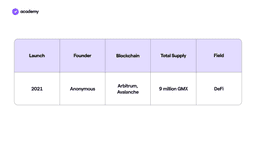What is GMX and how does it work?
September 19, 2023
10 min

GMX is a crypto and a DEX, and in particular the most popular derivatives exchange of 2023. We’ll elaborate below on what it is, the reasons for its success and the developments that await this DeFi protocol.
GMX: what is it?
To define more precisely what GMX is, we must specify that, in addition to being a crypto, it is a decentralised exchange for perpetual contracts.
Contrary to what often happens, therefore, GMX does not offer a cryptocurrency and a blockchain, but a specific DeFi protocol.
Perpetuals are derivative instruments that are rather rare in traditional finance, and more widely used in DeFi due to their flexibility. Perpetuals based on cryptocurrencies reflect the value of cryptocurrencies without requiring the purchase or direct custody of them, and unlike other popular derivatives such as futures they do not have an expiration date. This type of instrument is used in some DEXs to facilitate leverage trading.
GMX is available on both Arbitrum and Avalanche, both blockchains known to be scalable and convenient. The DEX is characterised by low fees, low price slippage and up to 50x leverage. Its model allows for highly efficient trading, aiming to solve a widespread problem in the decentralised exchange industry, that of capital efficiency. Indeed, the capital traded by DEX users is often threatened by slippage, impermanent loss and other risks, in addition to normal volatility.
Impermanent Loss
Impermanent loss indicates the loss you might suffer by providing liquidity compared to simply holding tokens. This “potential” loss occurs when there are large price variations, so the quantity of tokens in a liquidity pool is rebalanced. Example: in the ETH/USDC pair (a stablecoin) I deposited 0.5 ETH and 2000 USDC, when ETH was worth 4000$. If suddenly the price rises to $6000, the pool will have to convert ETH to USDC so that their ratio to price remains constant according to the DEX algorithm. So we could lose ETH. Of course as a result of other price movements the ETH in the pool could rise again, in fact the “impermanent” loss is not realised until I withdraw my liquidity from the pool.
Before we get into how the protocol works, let’s find out a little more about the project itself and how it came into being, so that we can better understand what GMX is.
How GMX was born and its governance
Approaching a new crypto like this, one may ask what is GMX, a DAO, a foundation, a company?
At the moment, the organisation of the protocol has no official form, but is entrusted to a section of the app that allows GMX governance token holders to propose and vote on initiatives.
Incidentally, as is often the case in more decentralised ecosystems, little is known about the founders of GMX or its history. We do, however, know of some key people within the community. We have, for example, the names of Krunal Amin, the founder of UniDex, and Benjamin Simon, the co-founder of Stealth Crypto, who are two of the people authorised to sign the multisig wallet in which the project’s funding funds are kept.
Speaking of funds, these came mainly from large investors and a previous sale of tokens. In fact, before migrating to Arbitrum, the DEX was called ‘Gambit‘, was based on the BNB Chain and included 4 tokens, the initial sale of which had raised funds. Of this capital, 6 million in GMX would later be transferred to the new treasury at the time of the migration and rebranding.
In terms of Venture Capital and funds involved, for instance, Blocktower bought GMX for a value of over 2,400 ETH and staked 336,478 of them. Flood Capital is also among the major holders of the crypto, although the amount of the investment is not publicly known. The most prominent hodler, however, is Arthur Hayes, founder and former CEO of BitMEX, who is said to own over 200,000 GMX.
How GMX works: the GLP pool
So let’s return to the initial question: what is it that differentiates GMX from other decentralised trading solutions? First of all, its liquidity system.
In fact, it has only one liquidity pool, the GMX Liquidity Pool, which contains all the assets offered by its market.
The GLP is composed of approximately 50% stablecoins (USDC, USDT, DAI, FRAX) and the remaining 50% of high-capitalisation cryptos.
On Arbitrum, these are BTC, ETH, LINK, UNI. On Avalanche, BTC, WBTC, WETH and AVAX.
Like all DEX liquidity pools, the GLP also has the function of providing liquidity to market exchanges and is supplied directly by users as ‘Liquidity Providers’ in return for rewards.
Those who choose to provide liquidity are incentivised to do so for tokens that are in short supply in the pool, through higher rewards. Likewise, there is an incentive to withdraw liquidity for excess assets, which unbalance the balance needed in the pool.
When an LP deposits a certain amount of assets in the GLP, they ‘mint‘ the equivalent in GLP tokens, which they will keep for later redemption along with the reward. When the LP decides to withdraw an asset from the GLP to obtain the reward, in fact, they burn the tokens they had minted.
Liquidity in the liquidity pool is ensured by various measures, including the Floor Price Fund of the GMX token, which serves as an emergency reserve in the event of a liquidity shortage. The fund is partly fed by trading fees for the GMX/ETH pair, which it converts into GLP tokens; and partly by 50% of OlympusDAO’s bond funds.
How trading on GMX works
What’s the main activity on GMX? From the user’s point of view, definitely trading.
As mentioned, traders on GMX can use leverage to open ‘short’ and ‘long’ positions on perpetuals of cryptocurrencies included in the GLP. Users trade against the pool, which also ensures a minimum spread between buying and selling prices and prevents slippage, allowing even high amounts to be traded immediately.
Prices on the platform are provided via decentralised oracles, thanks to Chainlink, which aggregate prices from the main centralised exchanges. This avoids liquidity risks from temporary volatility, which can wipe out the collateral (or margin) used by a user to open a trading position. When a user deposits collateral, GMX also captures a snapshot of its dollar value, ensuring that this does not change during the trade, even if the price of the underlying crypto changes. This allows for losses or gains proportional to the collateral used, without having to factor in any unwanted changes related to the underlying crypto.
Let’s make a brief comparison with the main competitor, dYdX, also a DEX for perpetuals ranked second by TVL after GMX itself:
- Leverage options: GMX up to 50x, dYdX up to 20x
- Supported collaterals: GMX multiple, dYdX only USDC
- Assets providing rewards: GMX multiple, dYdX only DYDX
- Supported networks: GMX Avalanche and Arbitrum, dYdX only Starkware (and in future the native chain)
All the ways to receive rewards on GMX
We mentioned rewards, but what is it on GMX that provides these incentives? There are mainly two activities: the provision of liquidity and crypto staking.
Liquidity providers on GMX receive 70% of the trading fees, in the form of esGMX and ETH tokens or AVAX depending on the network.
Stakers get the remaining 30% in the form of esGMX tokens, Multiplier Points and ETH or AVAX depending on the blockchain.
EsGMX stands for “Escrow GMX” and it’s a token that can be used in two ways: staking or vesting. Staking esGMX guarantees the same rewards as GMX, while vesting requires a minimum block of one year, during which time these Escrow tokens will be gradually converted into GMX.
Multiplier Points (MPs), on the other hand, reward long-term holders: you receive as many points as you have GMX in staking, while they are burnt when you take them out of staking, so as to incentivise holding. MPs can themselves be staked to earn fees in ETH or AVAX.
To recap, the DEX’s tokenomics involves numerous assets:
- the GMX token, dedicated to governance and staking;
- the esGMX token, which also allows vesting and is a reward;
- the GLP token, which is minted and burnt during the provision of liquidity;
- Multiplier Points, used as an incentive for holding:
- ETH or AVAX, which facilitate interoperability with their respective host ecosystems;
- The GM pool token, introduced with V2 of the protocol. Let’s take a quick look at what GMX V2 is.
V2 and the roadmap
The original version of the protocol is certainly advantageous and innovative compared to its competitors, but it is not perfect. In particular, the presence of only one liquidity pool limits the choice for liquidity providers with different risk exposure needs, as well as offering a limited number of assets.
Thus, version 2, accessible in beta since August 2023, was developed to address these limitations and integrate other improvements.
Here are the main changes available in V2:
- New fee structure;
- New assets for trading: SOL, XRP, LTC, DOGE, and ARB (the latter only on Arbitrum);
- The GM pool token for GMX V2 markets
- Higher execution speed and less slippage thanks to the new optimised Oracles system
- Incentives for different types of transactions to protect liquidity providers (long, short, swap)
- Isolated pools: liquidity in V2 is provided through isolated GM (GMX Market) pools. This allows liquidity providers to customise their exposure only to the tokens they prefer.
- The addition of markets for synthetic assets, which are created to replace tokens that the protocol does not directly support. This integration expands the range of (even traditional) assets that the platform can offer.
One of the next developments envisaged in the roadmap is X4, an optional AMM that will introduce fully customisable liquidity pools to feed new projects, promote composability and enable liquidity aggregation in other DEXs.
In short, the protocol seems to be increasingly rejoining the trend started by AMM-based DEXs. Will future developments therefore change the answer to the question ‘what is GMX’ and its crypto?



